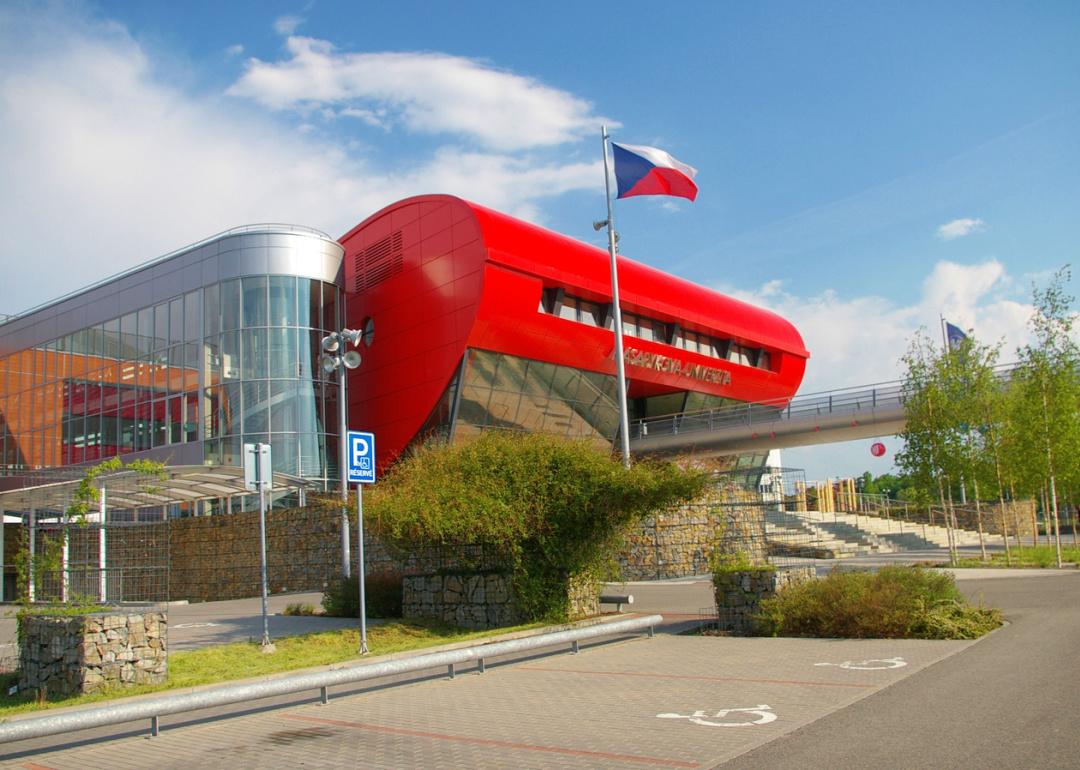Image



Alamogordo was once considered the technology hub of New Mexico. Known as the cradle of America’s space program, Alamogordo’s fascination with space spans decades, dating back to the testing done at White Sands Missile Range in the late 1940s. From the development and testing of the Atom Bomb to Space Research and testing Alamogordo was a location for scientist and engineers texting America's newest technologies. The economy was robust, the community was considered progressive for a Southern leaning city as one of the first to integrate in the late 1940's to 1950.
Throughout the decades, Alamogordo has played an important role in the air and space history of the United States and the military for top secret testing and technological developments. Home to Holloman Air Force Base and White Sands Missile Range it once was the home to technology and aerospace leaders such as Boeing, General Dynamics and others involved in space and military research.
The education system led by Alamogordo High School led the state not only in athletic accomplishment but also in academic leadership. Teachers were recruited from New York, Colorado and beyond as Alamogordo was the highest paying system in the western United States. During the 50's to the 70's the system generated science leaders who went on to lead major research projects as adults. Scientist and lecturers from the major universities and space and technology businesses mentored, hosted STEM clubs and taught guest classes at the local schools from middle school to high school.
The neighborhoods around McKinley Avenue to scenic were built for the Boeing and McDonald Douglas engineers. Then in the late 60's headquarters started shifting, the role of research shifted to other location and a brain drain of a sorts happened to the community. By the 80's a significant shift occurred hitting the business community and the brain drain was near complete by the turn into the 21st Century. Alamogordo went from an economic powerhouse and once comparable in size to Las Cruces in its earlier days to a community that now ranks in the bottom 1/3 in the nation in educational standards and is considered an impoverished community overtly reliant on the military bases for sustainability.
The is a glimpse of hope with business redevelopment via the arts happening in the city center and several STEM clubs developing via private enterprise. However, the politics of extremism has hampered business development in the last 2 years and the education system is of concern in business recruitment.
Alamogordo however is not unique to communities of the US in this century, sadly an emphasis on 21st Century technologies is taking second place in education. The University System of the United States still considered the best in the world is educating the world's children and not Americans on the good paying career skills of this century.
Nations Ranking for STEM Education, America not even in the Top 15...
Almost 3.5 million science, technology, engineering, and math jobs will need to be filled in the U.S. by 2025, according to a five-year governmental plan released in 2019.
In June 2019, millions of American jobs in STEM were unfilled. The federal government's five-year plan called for boosting STEM education to fill these roles and compete with incoming workers from around the world with STEM bachelor's degrees.
College Ave used data from the National Center for Education Statistics to rank the countries that in 2019 awarded the largest proportion of STEM bachelor's degrees. The data presented here is limited to the 38 countries in the Organization for Economic Cooperation and Development. Among those countries are the United States, South Korea, and Portugal. India and Russia are non-OECD countries and were not included in this ranking, but STEM degrees make up 33% and 29% of totals in those countries, respectively. As for the United States, STEM degrees make up 22.3% of bachelor's degrees.
The STEM degrees data set includes bachelor's, master's, and doctoral degrees, but this story focuses only on the percentage of bachelor's degrees awarded by field of study, level of degree, and country. The OECD average of STEM bachelor's degrees is 23.4%, the best country being Germany with 37.4% and the worst being Norway with 14.4%.
Among the largest number of STEM bachelor's degrees awarded, 13.5% are in the engineering, manufacturing, and construction fields; 5.5% in the study of natural sciences, mathematics, and statistics; and 4.5% in information and communication technologies.
Keep reading to learn more about the countries where the most STEM bachelor's degrees are awarded.

- Portion of bachelor's degrees that are STEM: 24%
--- Natural sciences, mathematics, and statistics: 4% (15th among OECD countries)
--- Information and communication technologies: 3.1% (31st)
--- Engineering, manufacturing, and construction: 17.2% (10th)
When it comes to science, Switzerland is among the most innovative research countries in the world—and it is also among the most competitive. Additionally, the ranking of the Swiss Federal Institute of Technology is fourth in Europe and 22nd in the world. Natural sciences play a big part in Swiss research, with a focus on sustainability projects, physics, and space research. In the country's corporate sector, important scientific fields include the metal industry, chemistry, pharmaceuticals, and technology—which also includes the electrical industry.
In Switzerland, as of 2017, the percentage of STEM graduates who are female was lower than any other OECD countries, with 22% in Switzerland, as compared to 26% in Germany, 28% in Austria, 32% in France, and 40% in Italy.

- Portion of bachelor's degrees that are STEM: 25%
--- Natural sciences, mathematics, and statistics: 5.6% (14th)
--- Information and communication technologies: 5.6% (8th)
--- Engineering, manufacturing, and construction: 13.7% (17th)
According to a study released by the OECD in 2017, STEM degrees are popular in the Czech Republic in large part because of how popular engineering is—which is far more popular than information and communication technologies and the natural sciences fields.
In 2015, 20% of Czech adults were tertiary-educated and were engineers, greater than the OECD average of 17% and the EU22 countries average of 18%. Something that explains this is the better employment prospects that engineers have in the Czech Republic. In 2016 in the Czech Republic, those who had a tertiary degree in information and communication technologies had an employment rate of 92%, and those who had an engineering, manufacturing, and construction degree had an employment rate of 91%. These were both higher than the information and communications technologies average of 88%, and engineering, manufacturing, and construction of 87% in OECD countries.
As a field of study, engineering in the Czech Republic is still highly dominated by men.

- Portion of bachelor's degrees that are STEM: 25%
--- Natural sciences, mathematics, and statistics: 5.7% (13th)
--- Information and communication technologies: 7.4% (4th)
--- Engineering, manufacturing, and construction: 12.% (22nd)
The STEM field in Estonia noticeably improved between 2013 and 2018—and the popularity and reputation of STEM improved in society, according to a study from 2019 that the Institute of Baltic Studies conducted along with HeiVäl Consulting.
Additionally, according to a Deloitte researchers' report from 2014, the Estonian government also has used national strategies to improve its research and development targets. Some of these strategies include training the number of researchers necessary to meet these targets and to promote employment conditions that are attractive in its public research institutions. Additionally, according to Kalli Kulla, Tuum's head of marketing and communications, Estonia has a high-quality education system, especially in information and communications technologies.
In 2019, 26% of women represented new engineering, manufacturing, and construction program entrants, and 25% represented new information and communication technology program entrants, as compared to 88% of women who represented new education field entrants.

- Portion of bachelor's degrees that are STEM: 25%
--- Natural sciences, mathematics, and statistics: 12.4% (12th)
--- Information and communication technologies: 3.9% (25th)
--- Engineering, manufacturing, and construction: 9.1% (31st)
Students who graduated with a STEM degree earned more than students who had graduated with a degree in arts, education, social science, business, health, or the humanities, according to a 2016 census that Statistics Canada carried out of immigrant and Canadian-born students between 25 and 34 with a bachelor's degree in STEM. This study also found that the STEM graduates were more likely to become employed as compared to the latter. It's also worth noting that, in Canada, international students can increase their likelihood of getting citizen status in Canada if they get degrees and work experience that are related to STEM.
As of 2019, women in Canada were also less likely to enter STEM fields, as well as more likely to end up leaving them. In 2019, women made up about one-third of all STEM postsecondary degree recipients in the country.

- Portion of bachelor's degrees that are STEM: 26%
--- Natural sciences, mathematics, and statistics: 3.3% (11th)
--- Information and communication technologies: 6.2% (7th)
--- Engineering, manufacturing, and construction: 16.4% (12th)
Young adults are less interested in STEM fields despite the fact that these fields led to increased employability, according to a 2017 OECD report. The STEM field employment rate in Hungary was 89%, higher than it was for the 85% of graduates with a tertiary education saw in terms of employment rate. The employment rate for graduates in information and communication technologies was 94%, but only 82% for tertiary education graduates who had an education degree.
As of 2019, Hungary had the lowest rate of female engineers and scientists in the European Union. Fewer than 7,000 women made up part of the total of 250,000 engineers and scientists in the country.

- Portion of bachelor's degrees that are STEM: 27%
--- Natural sciences, mathematics, and statistics: 2.4% (10th)
--- Information and communication technologies: 5% (12th)
--- Engineering, manufacturing, and construction: 19.5% (5th)
In 2016, students in Mexico were becoming increasingly interested in fields of study that were science-related. In that same year, one-quarter of those 25 to 64 in Mexico with tertiary education had a degree that was in one of the STEM fields—which was the same as the average across OECD countries.
A shift in interests could be seen in what entrants chose to pursue, with 32% of tertiary education new entrants in 2015 having chosen fields in STEM. This share was, for OECD countries, in the top four—and higher than the 27% OECD countries average. Employment rates for graduates of STEM fields, including engineering, manufacturing, and construction as well as information and communication technologies, aligned with this new educational trend and were higher than those for graduates of law, administration, and business.
However, for those who had studied the STEM field of natural science, mathematics, and statistics, the employment rate was 75%, which was below other STEM fields' rates. The percentage of women who were new tertiary STEM entrants in Mexico in 2015 was 32%, which was slightly higher than the OECD average of 27%.

- Portion of bachelor's degrees that are STEM: 27%
--- Natural sciences, mathematics, and statistics: 6.6% (9th)
--- Information and communication technologies: 4.5% (18th)
--- Engineering, manufacturing, and construction: 16.4% (13th)
In 2015, 32% of new entrants in Slovenia decided to enroll in a STEM field. This was above the 27% average of OECD countries. The highest share of these new entrants, 21%, chose to study engineering, manufacturing, and construction, followed by 6% who chose to study natural sciences, mathematics, and statistics, and then by 5% who chose to study information and communication technologies.
In 2016, the employment rate for graduates who had studied engineering, manufacturing, and construction was 90%, much higher than Slovenia's national average. The employment rate for graduates who had studied natural sciences, mathematics, and statistics was 69%, and 66% for those who had studied information and communication technologies.
In 2019, the percentage of new entrants in information and communication technologies programs who were women was 16%, and 23% in engineering, manufacturing, and construction programs. In contrast, 86% of education new entrants were women.

- Portion of bachelor's degrees that are STEM: 28%
--- Natural sciences, mathematics, and statistics: 9.4% (8th)
--- Information and communication technologies: 7.9% (1st)
--- Engineering, manufacturing, and construction: 10.7% (28th)
There are numerous STEM careers in Ireland's engineering and manufacturing industry. In 2020, the number of employees in Ireland's manufacturing sector was greater than 250,000—and eight out of the top 10 companies in the industrial automation industry had operations that were based in Ireland.
Additionally, 32% of Ireland's GDP made up the manufacturing and supply chain, which was notably higher than 15%, the European average. Out of the top 10 companies in the pharmaceutical industry, all of them were set up in Ireland and had more than 30,000 employees. Also, out of the top 15 companies in the medical engineering industry, 14 of them were set up in Ireland and had more than 20,000 employees.
In 2019, 26% of new engineering, manufacturing, and construction entrants were women, and out of those who were new entrants in information and communication technologies, 20% were women. For comparison, 72% of new education field entrants were women.

- Portion of bachelor's degrees that are STEM: 28%
--- Natural sciences, mathematics, and statistics: 3.1% (7th)
--- Information and communication technologies: 7.4% (3rd)
--- Engineering, manufacturing, and construction: 17.4% (8th)
Both international and national students in Finland were attracted to science-related programs, according to a report released by the OECD in 2017, and 29% of students studied in a STEM field, which was higher than 25%, the average for OECD countries. Additionally, when it came to new tertiary education entrants in 2015, 33% of them enrolled in a STEM field, as compared to the OECD average of 27%. International students studying in Finland were especially attracted to information and communication technology programs, with 17% having been enrolled in them as compared to the 6% OECD average.
As for the percentage of women in STEM in Finland, 26% of the engineering, manufacturing, and construction new entrants in 2019 were women—and 20% of information and communication technologies new entrants were women. These percentages are far lower than the 82% of women who were new entrants in the field of education.

- Portion of bachelor's degrees that are STEM: 28%
--- Natural sciences, mathematics, and statistics: 7.6% (6th)
--- Information and communication technologies: 3% (32nd)
--- Engineering, manufacturing, and construction: 17.8% (7th)
Between 2012 and 2016, the amount of its GDP that Greece spent on research went up from 0.08% to 0.99%. According to a report released by the OECD in 2017, the tertiary STEM graduates' employment rate ranged from 71% to 72%, which is only marginally higher than the tertiary graduate employment rate overall in Greece, which is 70%. These percentages are also lower than the average for OECD countries, which has a range that starts at 83% and ends at 88%—for natural sciences, mathematics, and statistics as well as information and communication technologies, respectively.
According to OECD findings from 2012, Greece came in second out of all countries—just after Italy—in terms of how many women chose to pursue natural sciences and engineering as their field in postsecondary education. In these fields, 44% of students were women, as compared to the OECD average of 34%. However, in 2019, 33% of engineering, manufacturing, and construction new entrants were women, and 30% of information and communication technologies new entrants were women—while in education, 82% of new entrants were women.

- Portion of bachelor's degrees that are STEM: 29%
--- Natural sciences, mathematics, and statistics: 9% (5th)
--- Information and communication technologies: 5.1% (10th)
--- Engineering, manufacturing, and construction: 14.5% (15th)
As of March 2014, Austria had reportedly experienced, along with Sweden and Hungary, recruitment difficulties when it came to STEM-related skills. According to a report released by the OECD in 2017, however, the employment rate for fields in STEM was just above 86%, with 84% having been the average employment rate for fields in STEM in OECD countries.
In 2019, 18% of new information and communication technology entrants were women. Of the new engineering, manufacturing, and construction entrants, 23% were women. In contrast, 78% of new entrants who entered the education field were women.

- Portion of bachelor's degrees that are STEM: 29%
--- Natural sciences, mathematics, and statistics: 3.8% (4th)
--- Information and communication technologies: 4.4% (20th)
--- Engineering, manufacturing, and construction: 21.1% (3rd)
The biotechnology sector in Lithuania grew by nearly 87% in 2020 in revenue terms—and, from 2011–2016, the annual average growth of Lithuania's life business sector was 22.1%. The World Economic Forum also recognized Lithuania in 2019 as being the best location for research and development within Eastern and Central Europe. According to a report released by the OECD in 2017, the employment rates in Lithuania for adults who were tertiary-educated and had studied health and business STEM fields were the highest in the country—with these fields, in 2016, having employment rates that were greater than 91%.
In 2019, 14% of new entrants studying information and communication technologies were women, and 23% of new entrants studying engineering, manufacturing, and construction were women. This gender disparity becomes clearer when looking at the 86% of new entrants studying education who were women.

- Portion of bachelor's degrees that are STEM: 29%
--- Natural sciences, mathematics, and statistics: 16.7% (3rd)
--- Information and communication technologies: 4.3% (22nd)
--- Engineering, manufacturing, and construction: 8.4% (33rd)
Between 2011 and 2021, the number of students in the United Kingdom taking STEM subjects at the university level increased—including an increase by 400% of students who wanted to take university-level artificial intelligence courses. Additionally, between 2011 and 2020, students enrolled in computer science courses went up by nearly 50%, and the number of engineering students went up by 21%.
According to a report released by the OECD in 2017, the percentage of tertiary students in the United Kingdom who were entering the natural sciences, mathematics, and statistics field was the highest out of OECD countries—but when it came to the engineering, manufacturing, and construction field, the United Kingdom was among the lowest.
In 2019, 25% of new engineering, manufacturing, and construction degree entrants in the United Kingdom were women, and 21% of new information and communication technology degree entrants were women. This was compared to the 78% of new education entrants who were women.

- Portion of bachelor's degrees that are STEM: 31%
--- Natural sciences, mathematics, and statistics: 5.8% (2nd)
--- Information and communication technologies: 4.9% (13th)
--- Engineering, manufacturing, and construction: 20.7% (4th)
In the '90s, South Korea incentivized the growth and innovation of STEM, and, more recently, the South Korean government increased how much it was spending on research and development—and these changes have been supported by a strong STEM education system. As a result, South Korea has seen high enrollment rates, more schools for students who are talented in science, and more students planning to pursue STEM professional and academic careers after graduation.
Through increased government funding, as well as a focus on the development of research programs in STEM fields, South Korea—along with China—raised the rankings of their universities worldwide as of April 2020, placing them within the top 500. To accomplish this, South Korea improved research infrastructure, funded graduate student scholarships and stipends, and invested $1.2 billion in specific university programs, with 62% of its research funding for top universities going to STEM disciplines.
However, it is important to note that, like many other countries in this list, there was a gender disparity when it came to new engineering, manufacturing, and construction program entrants, as well as new information communication and technology program entrants in 2019—with 21% and 27% of these being women, respectively.

- Portion of bachelor's degrees that are STEM: 37%
--- Natural sciences, mathematics, and statistics: 4.9% (1st)
--- Information and communication technologies: 4.7% (14th)
--- Engineering, manufacturing, and construction: 27.8% (1st)
According to a 2017 OECD report, 37% of recent tertiary graduates who had studied STEM in Germany reflected the country's strong technical focus. As for STEM employment rates, these were at 90% in 2016, just above the average employment rate in Germany. In 2020, Germany was first when it came to STEM subject popularity in the world that will be beneficial to its engineering industry—which, in recent years, had voiced concern frequently regarding young people lacking interest in technical subjects.
Gender differences in certain STEM fields in Germany were also noticeable in 2019, with 23% of new information and communication technology degree entrants being women—and 21% of new engineering, manufacturing, and construction degree entrants being women. This was as compared to the 79% of new education field entrants who were women.
Mexico and Canada in the Western Hemisphere are the new leaders in STEM Education as America's education system flounders.
Portions of this story originally appeared on College Ave and was produced and
distributed in partnership with Stacker Studio.